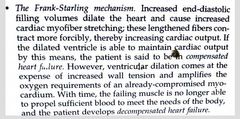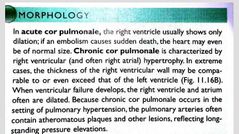![]()
![]()
![]()
Use LEFT and RIGHT arrow keys to navigate between flashcards;
Use UP and DOWN arrow keys to flip the card;
H to show hint;
A reads text to speech;
35 Cards in this Set
- Front
- Back

State frank starling law |

|
|
|
H |
B |
|
|
G |
H |
|
|
Define hypertensive heart disease |
Hypertensive heart disease (HHD) stems from the increased demands placed on the heart by hypertension (Systemic or Pulmonary hypertension) which causes pressure overload and ventricular hypertrophy. |
|
|
Major cardiac complications of hypertension results from |
1. Pressure overload 2. Ventricular hypertrophy |
|
|
...... is an adaptive response to pressure overload, and.... On the long run |
Myocyte hypertrophy, However, Persistent hypertension eventually can culminate in 1. Dysfunction 2. Cardiac dilations 3. CHF 4. and even sudden death.. |
|
|
Hypertensive heart disease most commonly affects |
The lady ventricle, secondary to systemic hypertension. |
|
|
Pulmonary hypertension can also cause |
Right-sided hypertension changes - so called corporate pulmonale |
|
|
Minimal Criteria for the diagnosis of systemic hypertensive heart disease |
(1) left ventricular hypertrophy (usually concentric) in the absence of other cardiovascular pathology and (2) a history or pathologic evidence of hypertension. |
|
|
Normal weight of the heart is |
U |
|
|
Morphology of systemic ( left-sided) HHD |
MORPHOLOGY 1. Grossly: hypertrophy, left ventricular wall thickening, increase heart weight , The thickness of the left ventricular wall may exceed 2.0 cm, and the heart weight may exceed 500 gm. In time the increased thickness of the left ventricular wall imparts a stiffness that impairs diastolic filling, often inducing left atrial enlargement .. 2. Microscopically: The biochemical, molecular, and morphologic changes that occur in hypertensive hypertrophy are similar to those noted in other conditions(eg aortic stenosis) associated with myocardial pressure overload. 1. Transverse diameter of Myocyte is increased 2. Prominent nuclear enlargement and hyperchromasia ( boxcar nuclei 3. Intracellular fibrosis |
|
|
Define pulmonary HHD / cor pulmonale |
Cor pulmonale, as isolated pulmonary HHD is frequently called, stems from pressure overload of the right ventricle,and is characterized by right ventricular hypertrophy, dilation, and potentially failure secondary to pulmonary hypertension . Pulmonary hypertension attributable to 1. Primary disorders of the lung parenchyma 2. Or pulmonary vasculature Note that - right ventricular dilation and hypertrophy caused by left ventricular failure or by congenital heart disease is substantially more common but is excluded by this definition. |
|
|
DISORDERS PREDISPOSING TO COR PULMONALE: |
1.Diseases of the pulmonary parenchyma: a. Chronic obstructive pulmonary disease, b. Diffuse pulmonary interstitial, c. fibrosis, d. Pneumoconioses and e. Cystic fibrosis. 2. Diseases of the pulmonary vessels : a. Recurrent pulmonary thromboembolism, b. Primary pulmonary hypertension and c. Extensive pulmonary arteritis. 3. DISORDERS AFFECTING CHEST MOVEMENT: a. Kyphoscoliosis, b.Marked obesity (sleep apnea, pickwickian syndrome) and c.Neuromuscular diseases. 4.DISORDERS INDUCING PULMONARY ARTERIAL CONSTRICTION : a. Metabolic acidosis , b. Hypoxemia , c. Chronic altitude sickness , d. Obstruction of major airways. |
|
|
List the types of |
1.Acute cor pulmonale can follow massive pulmonary embolism. 2.Chronic cor pulmonale results from right ventricular hypertrophy (and dilation) secondary to prolonged pressure overload, such as can occur with chronic lung diseases and a variety of other conditions. |
|
|
Morphology of cor pulmonale |

1. In acute cor pulmonale there is marked dilation of the right ventricle without hypertrophy. 2. In chronic cor pulmonale the right ventricular wall thickens. There is more subtle right ventricular hypertrophy. |
|
|
Cardiac cirrhosis |
Is hepatic fibrosis from severe hepatic congestion due to right heart failure |
|
|
Define ischemic heart disease |
Ischemic heart disease (IHD): is the generic designation for a group of pathophysiologically related syndromes resulting from myocardial ischemia—an imbalance between the supply (perfusion) and demand of the heart for oxygenated blood. Ischemia brings not only an insufficiency of oxygen, but also reduces the availability of nutrients and the removal of metabolites. IHD is often termed coronary artery disease (CAD) or coronary heart disease. |
|
|
Incidence of CHD / IHD |
1. Ischemic heart disease (IHD) is the leading cause of death worldwide for both men and women. 2. Chronic Atherosclerosis- more than 90% of patients with IHD have atherosclerosis of one or more of the coronary arteries. 3. Prevention is achieved by (1)modification of important risk factors, such as smoking, elevated blood cholesterol, and hypertension, and (2) diagnostic and therapeutic advances. |
|
|
1.The manifestation of IHD are a direct consequence of ? 2. The clinical presentation may include one or more of the following cardiac syndromes |
1. The insufficient blood supply to the heart . 2. a. Angina pectoris b. MI c. Chronic IHD with CHF d. Sudden cardiac death |
|
|
The term...... Is applied to any of the catastrophic manifestation of IHD - unstable angina, MI and SCD |
Acute coronary syndrome |
|
|
List events that can lead to / contribute to coronary atherosclerosis |
1. Inflammation 2. Thrombosis 3. Vasoconstriction |
|
|
Vasoconstriction in artherosclerotic plaques can be stimulated by |
1. Circulating Adrenergic agonists 2. Locally released platelet content 3. Imbalance btw Endothelial cell relaxing factors ( nitric oxide) and contracting factors ( endothelin) due to Endothelial dysfunction 4. Mediators released from perivascular inflammatory cells |
|
|
Pathogenesis of IHD |
The dominant cause of the IHD syndromes is insufficient coronary perfusion relative to myocardial demand, due to chronic progressive atherosclerotic narrowing of the epicardial coronary arteries, and variable degrees of superimposed 1. acute plaque change, 2. thrombosis, and 3. vasospasm. |
|
|
Discuss acute plaque change |
ACUTE PLAQUE CHANGE: Seen in Acute coronary syndromes (unstable angina, acute MI, and sudden cardic death). There is an abrupt conversion of a stable atherosclerotic plaque to an unstable and potentially life-threatening atherothrombotic lesion through a.rupture, b. superficial erosion, c. ulceration, d. fissuring, or e. deep hemorrhage. In most instances, the plaque change causes the formation of a superimposed thrombus that partially or completely occludes the affected artery. |
|
|
Define angina pectoris |
Angina pectoris (literally, chest pain) is characterized by paroxysmal and usually recurrent attacks of substernal or precordial chest discomfort (variously described as constricting, squeezing, choking, or knifelike) caused by transient (15 seconds to 15 minutes), reversible myocardial ischemia that falls short of inducing myocyte necrosis. |
|
|
Angina pectoris pain is a consequence of |
The ischamia induced release of 1. Adenosine 2. Bradykinin 3. And other molecules that stimulate autonomic nerves... |
|
|
1.List 2. And explain the variants of angina pectoris |
1. a. Stable / typical angina b. Unstable / crescendo angina c. Prinzmetal / variant angina 2. a. Prinzmetal variant angina is an uncommon form of episodic myocardial ischemia that is caused by coronary artery spasm b. Stable angina: Due to chronic stenosing coronary atherosclerosis. It is usually produced by physical activity, emotional excitement and also relieved by rest or a strong vasodilator.c. c. Unstable or crescendo angina :In most patients, unstable angina is caused by the disruption of an atherosclerotic plaque with superimposed partial (mural) thrombosis and possibly embolization or vasospasm (or both). |
|
|
About MI 1. Definition. 2. Incidence |
1. MI, also known as “heart attack,” is the death of cardiac muscle due to prolonged severe ischemia 2.Incidence and Risk Factors: a. MI can occur at virtually any age, but its frequency rises progressively with increasing age and when predispositions to atherosclerosis are present. b. Blacks and whites are equally affected. c. Throughout life, men are at significantly greater risk than women. Women tend to be protected from MI during reproductive age, oestrogen - so at menopause, there is increased CHD and IHD |
|
|
Pathogenesis of MI 1. Coronary artery occlusion |
1.Coronary Arterial Occlusion: This event occur in majority of transmural MI. i. Sudden change in an atheromatous plaque ii. Exposed to subendothelial collagen and iii. Platelets adhesion iv. Formation of microthrombi v. Vasospasm vi. Tissue factor activation →larger thrombus. vii. Complete occlusion of the vessel lumen . Other mechanisms have lesser occurrence in transmural MI : 2. Vasospasm with or without coronary atherosclerosis 3. Emboli from the left atrium or paradoxical emboli 4.Ischemia without detectable coronary atherosclerosis and thrombosis. |
|
|
Patterns of infarction 1.Patterns of InfarctionThe location, size, and morphologic features of an acutemyocardial infarct depend on multiple factors? 2. Patterns? Based on |
1. a. Size and distribution of the involved vessel b. Rate of development and duration of the occlusion c. Metabolic demands of the myocardium (affected, forexample, by blood pressure and heart rate) d. Extent of collateral supply 2. Based on the size of the involved vessels and the degree of collateral circulation a. Transmural infarction b. Subendothelial infarction c. Multifocal microscopic infarction d.
(1)Transmural Infarction: Most myocardial infarcts are transmural, in which the ischemic necrosis involves the full or nearly full thickness of the ventricular wall in the distribution of a single coronary artery. In contrast (2)Subendocardial (nontransmural) infarction constitutes an area of ischemic necrosis limited to the inner one third to one half of the ventricular wall. 3. Multifocal microscopic infarction -This pathology involves only intramural vessels. This can occur in the setting of vasculitis , vascular spasm due to endogenous cathecols and drugs eg cocain. |
|
|
Patterns of infarction and ECG changes |
Patterns - 1. Transmural infarction - ST segment elevation ( STEMIs)b. Subendothelial infarction -ST segment depression (NSTEMIs )c. Multifocal microscopic infarction
|
|
|
Morphology of MI |
1. The gross and microscopic appearances of MI depends on the age of the injury 2. Myocardial infarcts less than 12 hrs old are not grossly apparent . 3. Features of irreversible injury on light microscope a. variable waviness of fibers b. coagulation necrosis,edema and hemorrhage c. contraction band necrosis d. neutrophilic infiltrate e. loss of nuclei and striations f. formation of fibrovascular granulation tissue at margins g. collagen deposition leading to scar formation |
|
|
Myocardial infarcts ....... old are not grossly apparent . |
Myocardial infarcts less than 12 hrs old are not grossly apparent . |
|
|
Clinical features of MI |
i Chest pain ii Rapid, weak pulse iii Profuse sweating iv Dyspnea due to impaired contractility of the ischemic myocardium and the resultant pulmonary congestion and edema . |
|
|
Complication of MI |
1.Contractile dysfunction 2.Arrhythmias 3.Myocardial rupture: Lead to hemopericardium and cardiac tamponade 4.Pericarditis 5.Right ventricular infarction 6.Mural thrombus. 7. Ventricular aneurysm. |

